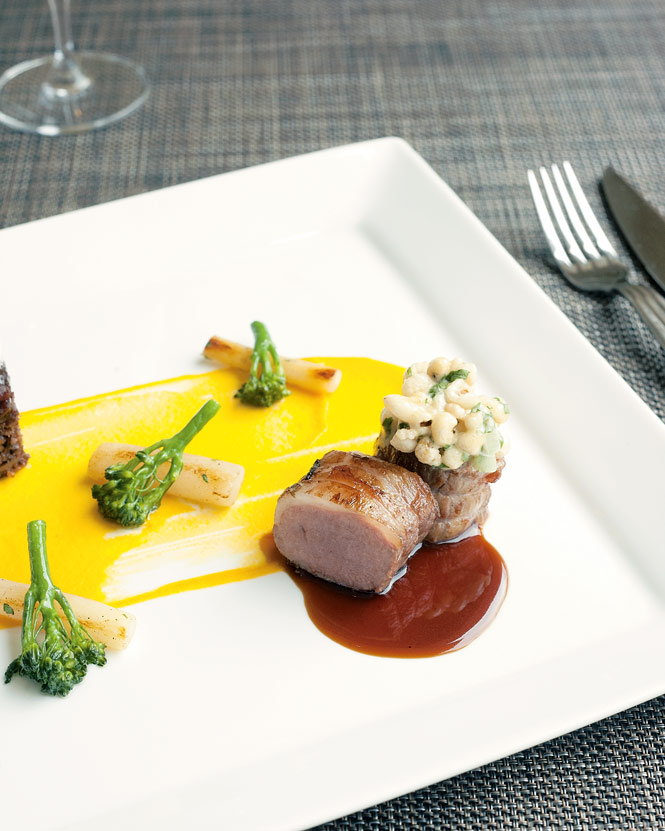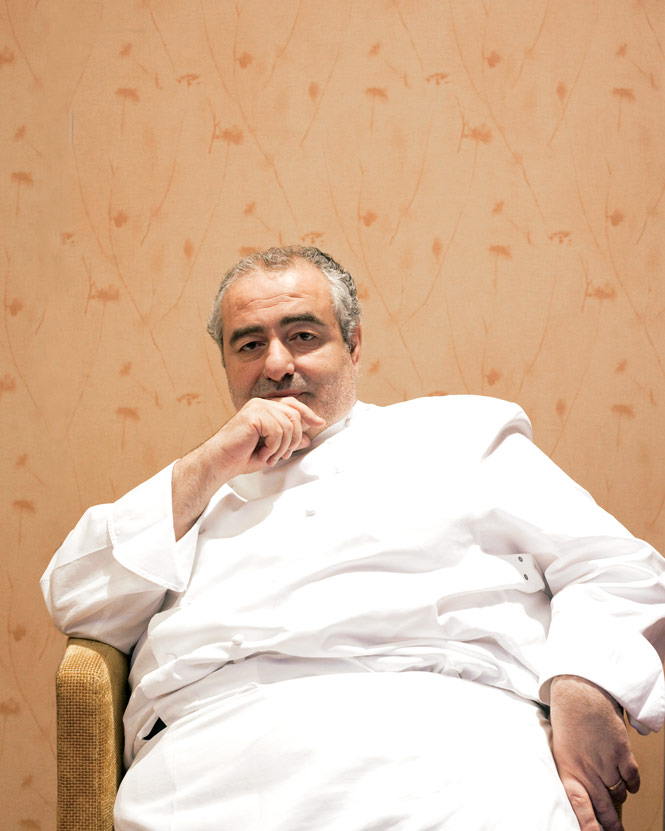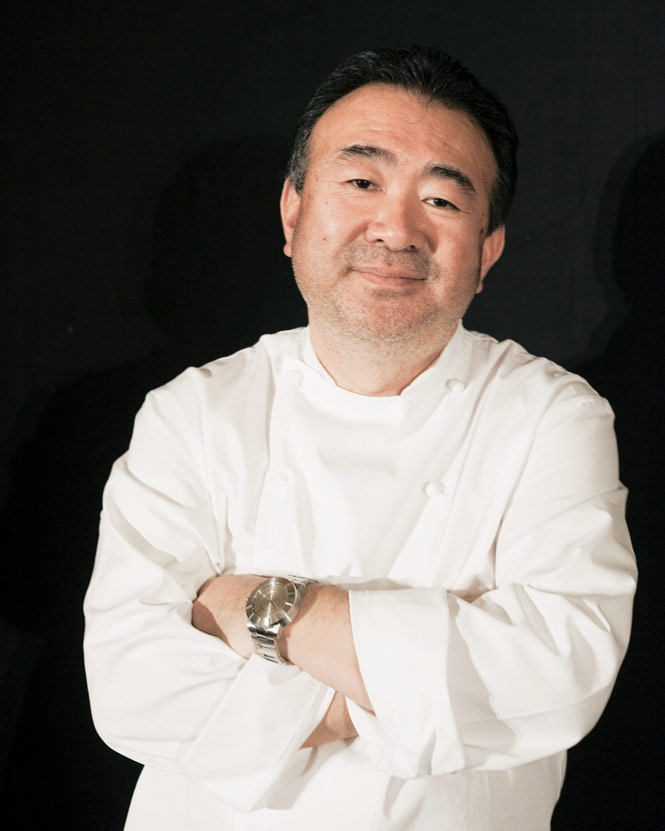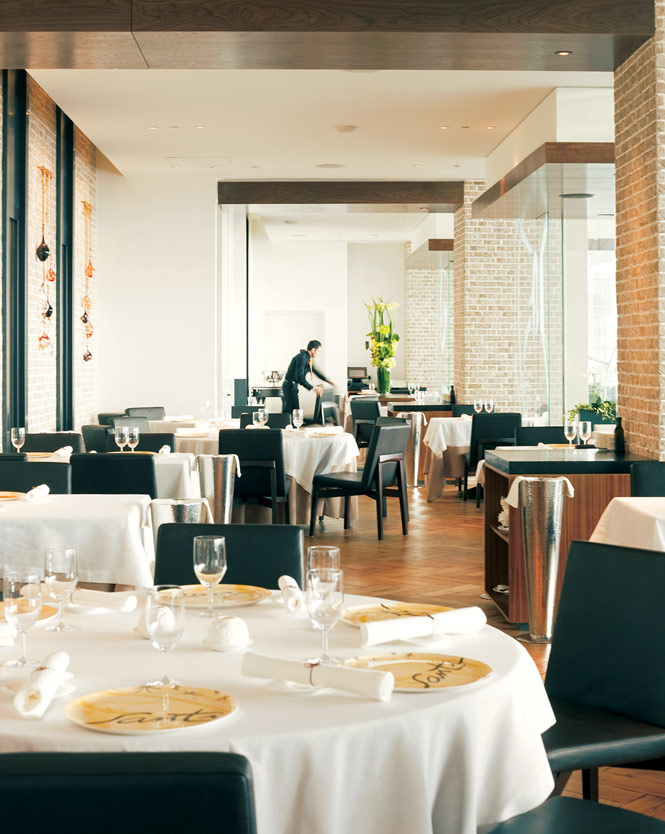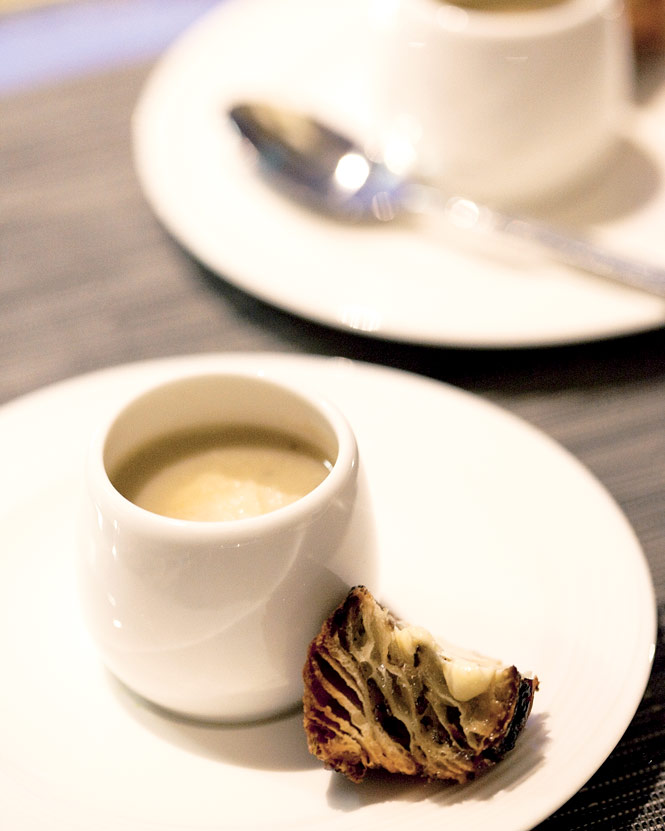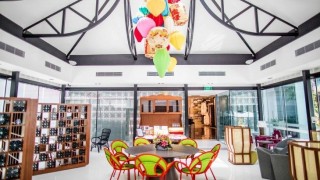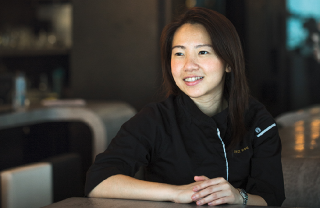Above: Confit of ocean trout at Waku Ghin.
Five high-profile chefs are heating up the city-state’s dining scene
By Natasha Dragun
Photographs by Lauryn Ishak
You’ve bought their books, watched them cook up a storm on television, and drooled over their gastronomic creations—“they” being among the crème de la crème of the culinary world, chefs who have achieved celebrity status for the magic they work with food. And thanks to the launch of Singapore’s two “integrated resorts,” Marina Bay Sands and Resorts World Sentosa, you no longer have to jet off to Madrid, Sydney, or Paris to enjoy their offerings. Read on for a taste of the city-state’s five newest fine-dining establishments and the Michelin-starred talent they open the door to.
Chinois by Susur Lee
Hong Kong–born Canadian chef Susur Lee is no stranger to Singapore. The culinary consultant for the Tung Lok restaurant group, Lee landed in the city-state in 1997 to open Club Chinois, a mod-Chinese affair that shut its doors last year to pave the way for this, Lee’s newest eatery. Tucked away at the back of Hotel Michael, the restaurant takes its culinary cues from Lee’s four North American restaurants, applauded for their creative cuisine blending flavors from the chef’s Chinese upbringing with classic French ingredients.
The result is a menu almost poetic in nature, and more akin to a glossy coffee-table book than a compendium of food. The dining room is equally striking, fitted out with granite walls, walnut tables, and a ceiling painted the same shade of red as Beijing’s Forbidden City.
Aside from a handful of regional Chinese dishes, the food is decidedly fusion. How else do you describe Peking duck paired with foie gras? Instead of pancakes and plum sauce, the smoked duck sits beside a perfectly seared wedge of goose liver, presented with a crisp egg roll and an orange reduction that cuts right through the richness of the meat. The abalone soup is another surprise. Usually served with shark’s fin in a bland broth, the abalone in Lee’s dish is stuffed inside an enormous crab claw immersed in a mustardy sea-urchin sauce. It’s bold, bright, and delicious.
Lee also reinvents Singapore’s national dish, chili crab, using tiger prawns doused with a fiery spice that’s only softened by spongy cigar buns—Lee’s take on Chinese mantou rolls. It’s a heady combination that I’m still dreaming about hours after I’ve skewered the last morsel of prawn from its shell (Hotel Michael, Resorts World Sentosa, 26 Sentosa Gateway; 65/6884-7888).
Guy Savoy
Chef Guy Savoy may want his Marina Bay Sands eatery to be less formal than his French outfit, but the fancy imported ingredients on the menu tell a different story. It’s a short list, and yet delicacies like caviar, foie gras, and truffle all make repeat appearances. Small wonder, given that the dishes represent a selection of crowd pleasers from Savoy’s three-Michelin-starred restaurant in Paris. “I want to re-create that same experience here,” he says. “But with a more relaxed ambience.”
His dining room in Singapore does have some bistro-esque features: it’s intimate and warm, with slate-hued banquettes and a glass-encased wine cellar. But serious money has been spent on flourishes like crisp linens, crystal glassware, and floor-to-ceiling windows framing an impressive view of the bay.
To taste why Savoy has so many Michelin stars (his Las Vegas restaurant also has two), order the 10-course “menu prestige.” Among the starters is the chef’s legendary oysters in ice gelée: Kusshi mollusks resting on an oyster-and-cream puree topped with a film of oyster-kissed gelatin. Equally flavorful is the artichoke and black-truffle soup, topped with shavings of pungent Parmigiano Reggiano. I use my toasted mushroom brioche to scoop up the ethereal medley of cheese and truffle, which seems to float over a luscious canvas of artichoke.
This is one restaurant where dessert is truly part of the meal and not just a palette-cleansing addendum. As it well should be when it costs S$50 (about US$36). Save room for the sweets trolley, which comes overladen with treats like homemade ice cream and sorbet in flavors such as toasted almond and tangerine; canisters of fluffy marshmallows; jars of compotes, caramels, and curds; mini-muffins and cakes. Just when I’m about to slip into a sugar coma, the waiter brings out chocolate bon bons infused with cognac, so smooth that they melt the minute they’re in my mouth. And suddenly, S$50 seems like a bargain (10 Bayfront Ave., 2/F-01, Marina Bay Sands; 65/6688-8513).
Osia
Australian restaurateur Scott Webster is adamant that his new Singapore eatery does not serve mod-Oz fare. “Osia serves Osia cuisine,” he says, which is probably best translated as a menu highlighted by antipodean ingredients with Asian flair. Webster caused a sensation in 2003 when he opened a restaurant by the same name in London, his use of native Australian flavors proving an instant hit among British diners. The eatery has since closed, but Webster—behind Australian Culinary Consultants, a group promoting Australian products internationally—has done a fine job re-creating the experience at his breezy Resorts World establishment.
Any gourmand will tell you to skip the bread when you’re tackling a menu of countless courses, but Webster’s loaves should not be shunned. They’re baked fresh on a stone hearth, and come served with homemade dips like eggplant or macadamia and cheese. The only thing that stops me from devouring an entire loaf is the arrival of my entree: test tubes filled with fruit-flavored ice and seafood. At first glance, the dish looks like a chemistry experiment gone awry. But the contrast between the sweet ice and salty fish works well, particularly in pairings like quandong with shrimp and watermelon with lilly pilly and lobster.
Test-tube concoctions aside, the majority of Webster’s menu is clean and pared back, allowing the fresh ingredients to speak for themselves. A starter of ocean trout is simply cured with seasalt and Chinese vinegar, while milk-fed Tasmanian lamb barely touches the pan before being served on a swirl of creamed carrots. My only disappointment of the meal comes from learning that the kitchen won’t let me a take away a tub of the onion-and-quandong marmalade that accompanied my meat—it’s one of the most exciting condiments I’ve tasted in a long time, but it’s not for sale.
I decide to lift my spirits by whiling away the rest of the day in the restaurant’s lovely, light-filled dining room, enjoying coffee and dessert. From the open kitchen, Webster’s chefs woo me with all manner of chocolatey treats, but I have my heart set on the macadamia tart with wattle-seed filo crisps. If that’s not modern Australia in a nutshell, I don’t know what is (Crockfords Tower, Resorts World Sentosa, 8 Sentosa Gateway; 65/6577-8899).
Santi
“My real obsession is to eat—I’m always looking for someone to cook for me,” says Santi Santamaria, stating the obvious. The Catalan chef clearly loves his food, and gets to show off his favorite dishes in Singapore at Santi, his first restaurant in Asia and third worldwide. Just don’t come here expecting paella and sangria. “The food is cocina de mercado; it’s market cuisine,” says the fiftysomething chef. “But it’s Mediterranean, not Spanish as most people know it.”
It’s a winning formula that’s already seen the self-taught cook secure three Michelin stars for his restaurant Can Fabes in Sant Celoni, his hometown; his second dining room, Santceloni in Madrid, may not have any stars attached to it, but it’s equally applauded for its modern interpretation of Catalan cuisine.
While Santi’s Singapore menu is inspired by its European counterparts, there are distinct Asian overtones; with a menu that changes daily, Santamaria had little choice but to include local produce. My degustation begins with a wafer-thin slice of octopus drizzled with a superb Romanesco sauce that at first hints of garlic before the mellow flavor of roasted almonds, pine nuts, and hazelnuts settles on the tongue. There’s also migas, a hearty village dish of egg and stale bread that Santi transforms from proletarian to posh by adding slivers of summer truffle to poached quail eggs, drizzled with an artisinal olive oil made especially for his restaurants.
Aside from the unfussy dining room—glass-tiled walls, crisp white linen, exposed brisk—what sets Santi apart from other establishments of its type is the unconventional pairing of ingredients. Few would think to top sweet Gillardeau oysters with cabbage and blood orange, fearful of overpowering the delicate flavor of the seafood. But Santi’s dish is impeccable, the creaminess of the oysters enhanced by the acidity of the fruit. Another citrus, lime, is used to cure trevally served with fava beans and a touch of salicornia. Candied kumquats have the same effect on an escabeche of foie gras. “This food comes from the heart. There’s no recipe, it’s just intuitive,” Santamaria says (10 Bayfront Ave., 2/F-03, Marina Bay Sands; 65/6688-8501).
Waku Ghin
If you want to dine at Tetsuya Wakuda’s eponymous restaurant in Sydney, be prepared to book a table at least four months in advance—the waiting list to get into the 140-seat eatery is that long. With space for just 28 diners, the Japanese-Australian chef’s new Singapore establishment may well become the holy grail of the city’s fine-dining circuit.
Segmented into four areas, the restaurant—Tetsuya’s first foray outside Australia—sees guests out of their seats and moving rooms between courses. I’m welcomed into a cool, ocean-inspired lounge area where sheets of silky fabric hang from the ceiling casting wavelike shadows over walls inlaid with mother-of-pearl. Mains will follow in another area; dessert and digestifs in yet others. “The idea is to have four spaces, with four chef’s tables,” says Tetsuya. “The kitchen will come to you.”
Given the aquatic overtone in the first room, it’s no surprise that seafood stars on the menu—well, one particular seafood, and bountiful varieties of it. In Waku Ghin’s “sake and caviar lounge,” one can nibble on beluga, starlet, osetra, and sevruga—a teaspoon of the former atop a softly poached quail egg is pure bliss, the silky egg white and semi-frozen yolk enveloping the plump roe to create the perfect balance of textures and flavors. It’s washed down with sake, a number of varieties of which have been crafted especially for Tetsuya by Japan’s oldest distillery.
The rest of the menu is as creative as it is sophisticated, with small plates highlighting seasonal produce, much of it local. Still, in terms of flavor, the food is mod-Japanese-meets-nouvelle-French, with a hint of antipodean flair thanks to ingredients like Tasmanian leatherwood honey and ocean trout.
The meal begins with thin slices of scampi paired with junsai, a type of straw mushroom, and a spoon of tofu so silky that it melts on my tongue like meringue. The confit of ocean trout is another winning order, and still makes an appearance on Tetsuya’s menu in Sydney. While some foodies liken it to Led Zeppelin’s “Stairway to Heaven”—good, but overplayed—it’s a dish that’s hard to fault on the palette. The bite-size morsel of lean fish is dusted with konbu and set atop a salad of apple and fennel: it’s like spring on a plate. Despite the appearance of such signature dishes, Tetsuya tells me that most of the menu will be unique to Singapore: “It won’t duplicate Sydney. It’s an evolution. Australia has such strict quarantine regulations. It will be fun to play with new ingredients here” (10 Bayfront Ave., 2/F-03, Marina Bay Sands; 65/6688-8501).
Originally appeared in the August/September 2010 print issue of DestinAsian magazine (“Singapore’s New Stars”)


